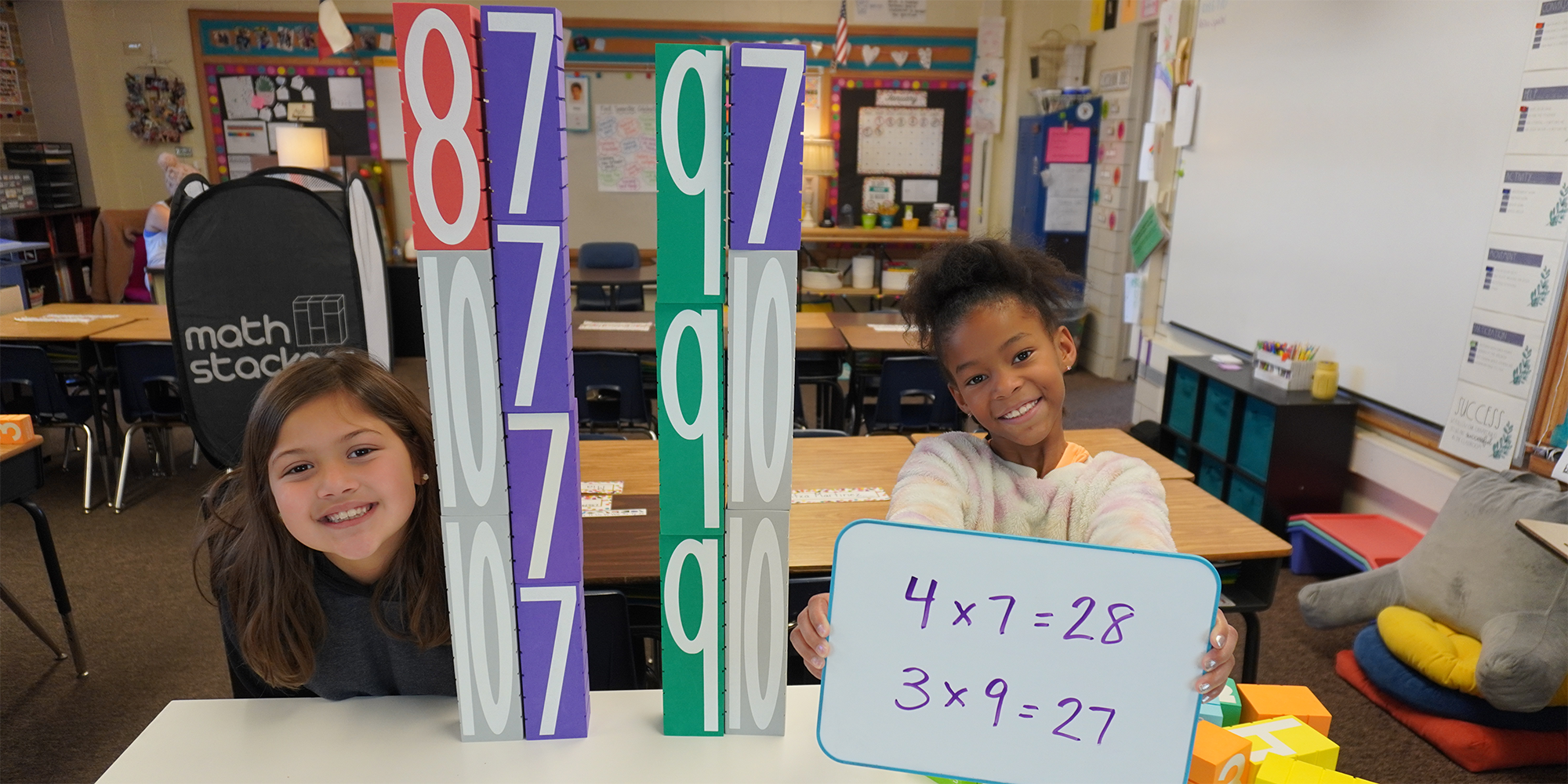*Click above to view standards for 3rd grade addition & subtraction, multiplication, & fractions.
TEKS: ADDITION, SUBTRACTION, & DATA ANALYSIS
3.1 Mathematical process standards. The student uses mathematical processes to acquire and demonstrate mathematical understanding. The student is expected to:
- A. Apply mathematics to problems arising in everyday life, society, and the workplace;
- B. Use a problem-solving model that incorporates analyzing given information, formulating a plan or strategy, determining a solution, justifying the solution, and evaluating the problem-solving process and the reasonableness of the solution;
- C. Select tools, including real objects, manipulatives, paper and pencil, and technology as appropriate, and techniques, including mental math, estimation, and number sense as appropriate, to solve problems;
- D. Communicate mathematical ideas, reasoning, and their implications using multiple representations, including symbols, diagrams, graphs, and language as appropriate;
- E. Create and use representations to organize, record, and communicate mathematical ideas;
- F. Analyze mathematical relationships to connect and communicate mathematical ideas;
- G. Display, explain, and justify mathematical ideas and arguments using precise mathematical language in written or oral communication.
3.5 Algebraic reasoning. The student applies mathematical process standards to analyze and create patterns and relationships. The student is expected to
- A. Represent one- and two-step problems involving addition and subtraction of whole numbers to 1,000 using pictorial models, number lines, and equations; Readiness Standard.
3.8 Data analysis. The student applies mathematical process standards to solve problems by collecting, organizing, displaying, and interpreting data. The student is expected to:
- A. summarize a data set with multiple categories using a frequency table, dot plot, pictograph, or bar graph with scaled intervals; and
- B. solve one- and two-step problems using categorical data represented with a frequency table, dot plot, pictograph, or bar graph with scaled intervals.
COMMON CORE: ADDITION, SUBTRACTION, MEASUREMENT & DATA
Operations & Algebraic Thinking:
Solve problems involving the four operations, and identify and explain patterns in arithmetic.
- 3.OA.D.9 Identify arithmetic patterns (including patterns in the addition table or multiplication table), and explain them using properties of operations. For example, observe that 4 times a number is always even, and explain why 4 times a number can be decomposed into two equal addends.
Measurement & Data
Represent and interpret data.
- 3.MD.B.3 Draw a scaled picture graph and a scaled bar graph to represent a data set with several categories. Solve one- and two-step "how many more" and "how many less" problems using information presented in scaled bar graphs. For example, draw a bar graph in which each square in the bar graph might represent 5 pets.
TEKS: MULTIPLICATION
3.1 Mathematical process standards. The student uses mathematical processes to acquire and demonstrate mathematical understanding. The student is expected to:
- A. Apply mathematics to problems arising in everyday life, society, and the workplace;
- B. Use a problem-solving model that incorporates analyzing given information, formulating a plan or strategy, determining a solution, justifying the solution, and evaluating the problem-solving process and the reasonableness of the solution;
- C. Select tools, including real objects, manipulatives, paper and pencil, and technology as appropriate, and techniques, including mental math, estimation, and number sense as appropriate, to solve problems;
- D. Communicate mathematical ideas, reasoning, and their implications using multiple representations, including symbols, diagrams, graphs, and language as appropriate;
- E. Create and use representations to organize, record, and communicate mathematical ideas;
- F. Analyze mathematical relationships to connect and communicate mathematical ideas;
- G. Display, explain, and justify mathematical ideas and arguments using precise mathematical language in written or oral communication.
3.4 Number and operations. The student applies mathematical process standards to develop and use strategies and methods for whole number computations in order to solve problems with efficiency and accuracy. The student is expected to:
- D. Determine the total number of objects when equally-sized groups of objects are combined or arranged in arrays up to 10 by 10;
- E. Represent multiplication facts by using a variety of approaches such as repeated addition, equal-sized groups, arrays, area models, equal jumps on a number line, and skip counting; Supporting Standard.
- F. Recall facts to multiply up to 10 by 10 with automaticity and recall the corresponding division facts;
- G. Use strategies and algorithms, including the standard algorithm, to multiply a two-digit number by a one-digit number. Strategies may include mental math, partial products, and the commutative, associative, and distributive properties;
- H. Determine the number of objects in each group when a set of objects is partitioned into equal shares or a set of objects is shared equally;
- I. Determine if a number is even or odd using divisibility rules;
- J. Determine a quotient using the relationship between multiplication and division; and
- K. Solve one-step and two-step problems involving multiplication and division within 100 using strategies based on objects; pictorial models, including arrays, area models, and equal groups; properties of operations; or recall of facts.
3.5 Algebraic reasoning. The student applies mathematical process standards to analyze and create patterns and relationships. The student is expected to:
- B. Represent and solve one- and two-step multiplication and division problems within 100 using arrays, strip diagrams, and equations;
- C. Describe a multiplication expression as a comparison such as 3 x 24 represents 3 times as much as 24; Supporting Standard.
- D. Determine the unknown whole number in a multiplication or division equation relating three whole numbers when the unknown is either a missing factor or product; Supporting Standard.
3.6 Geometry and measurement. The student applies mathematical process standards to analyze attributes of two-dimensional geometric figures to develop generalizations about their properties. The student is expected to:
- C. Determine the area of rectangles with whole number side lengths in problems using multiplication related to the number of rows times the number of unit squares in each row;
- D. Decompose composite figures formed by rectangles into non-overlapping rectangles to determine the area of the original figure using the additive property of area.
COMMON CORE: MULTIPLICATION
Operations & Algebraic Thinking:
Represent and solve problems involving multiplication and division.
- 3.OA.A.1 Interpret products of whole numbers, e.g., interpret 5 × 7 as the total number of objects in 5 groups of 7 objects each. For example, describe a context in which a total number of objects can be expressed as 5 × 7.
- 3.OA.A.2 Interpret whole-number quotients of whole numbers, e.g., interpret 56 ÷ 8 as the number of objects in each share when 56 objects are partitioned equally into 8 shares, or as a number of shares when 56 objects are partitioned into equal shares of 8 objects each. For example, describe a context in which a number of shares or a number of groups can be expressed as 56 ÷ 8.
- 3.OA.A.3 Use multiplication and division within 100 to solve word problems in situations involving equal groups, arrays, and measurement quantities, e.g., by using drawings and equations with a symbol for the unknown number to represent the problem.
- 3.OA.A.4 Determine the unknown whole number in a multiplication or division equation relating three whole numbers. For example, determine the unknown number that makes the equation true in each of the equations 8 × ? = 48, 5 = _ ÷ 3, 6 × 6 = ?
Understand properties of multiplication and the relationship between multiplication and division.
- 3.OA.B.5 Apply properties of operations as strategies to multiply and divide.2 Examples: If 6 × 4 = 24 is known, then 4 × 6 = 24 is also known. (Commutative property of multiplication.) 3 × 5 × 2 can be found by 3 × 5 = 15, then 15 × 2 = 30, or by 5 × 2 = 10, then 3 × 10 = 30. (Associative property of multiplication.) Knowing that 8 × 5 = 40 and 8 × 2 = 16, one can find 8 × 7 as 8 × (5 + 2) = (8 × 5) + (8 × 2) = 40 + 16 = 56. (Distributive property.)
- 3.OA.B.6 Understand division as an unknown-factor problem. For example, find 32 ÷ 8 by finding the number that makes 32 when multiplied by 8.
Multiply and divide within 100.
- 3.OA.C.7 Fluently multiply and divide within 100, using strategies such as the relationship between multiplication and division (e.g., knowing that 8 × 5 = 40, one knows 40 ÷ 5 = 8) or properties of operations. By the end of Grade 3, know from memory all products of two one-digit numbers.
Solve problems involving the four operations, and identify and explain patterns in arithmetic.
- 3.OA.D.9 Identify arithmetic patterns (including patterns in the addition table or multiplication table), and explain them using properties of operations. For example, observe that 4 times a number is always even, and explain why 4 times a number can be decomposed into two equal addends.
Number & Operations in Base Ten
Use place value understanding and properties of operations to perform multi-digit arithmetic.
- 3.NBT.A.1 Multiply one-digit whole numbers by multiples of 10 in the range 10-90 (e.g., 9 × 80, 5 × 60) using strategies based on place value and properties of operations.
Measurement & Data
Geometric measurement: understand concepts of area and relate area to multiplication and to addition.
- 3.MD.C.7 Relate area to the operations of multiplication and addition.
- 3.MD.C.7.A Find the area of a rectangle with whole-number side lengths by tiling it, and show that the area is the same as would be found by multiplying the side lengths.
- 3.MD.C.7.B Multiply side lengths to find areas of rectangles with whole-number side lengths in the context of solving real world and mathematical problems, and represent whole-number products as rectangular areas in mathematical reasoning.
- 3.MD.C.7.C Use tiling to show in a concrete case that the area of a rectangle with whole-number side lengths a and b + c is the sum of a × b and a × c. Use area models to represent the distributive property in mathematical reasoning.
- 3.MD.C.7.D Recognize area as additive. Find areas of rectilinear figures by decomposing them into non-overlapping rectangles and adding the areas of the non-overlapping parts, applying this technique to solve real world problems.
Geometric measurement: recognize perimeter.
- 3.MD.D.8 Solve real world and mathematical problems involving perimeters of polygons, including finding the perimeter given the side lengths, finding an unknown side length, and exhibiting rectangles with the same perimeter and different areas or with the same area and different perimeters.
TEKS: FRACTIONS
3.1 Mathematical process standards. The student uses mathematical processes to acquire and demonstrate mathematical understanding. The student is expected to:
- A. Apply mathematics to problems arising in everyday life, society, and the workplace;
- B. Use a problem-solving model that incorporates analyzing given information, formulating a plan or strategy, determining a solution, justifying the solution, and evaluating the problem-solving process and the reasonableness of the solution;
- C. Select tools, including real objects, manipulatives, paper and pencil, and technology as appropriate, and techniques, including mental math, estimation, and number sense as appropriate, to solve problems;
- D. Communicate mathematical ideas, reasoning, and their implications using multiple representations, including symbols, diagrams, graphs, and language as appropriate;
- E. Create and use representations to organize, record, and communicate mathematical ideas;
- F. Analyze mathematical relationships to connect and communicate mathematical ideas;
- G. Display, explain, and justify mathematical ideas and arguments using precise mathematical language in written or oral communication.
3.3 Number and operations. The student applies mathematical process standards to represent and explain fractional units. The student is expected to:
- A. Represent fractions greater than zero and less than or equal to one with denominators of 2, 3, 4, 6, and 8 using concrete objects and pictorial models, including strip diagrams and number lines; Supporting Standard;
- B. Determine the corresponding fraction greater than zero and less than or equal to one with denominators of 2, 3, 4, 6, and 8 given a specified point on a number line;
- C. Explain that the unit fraction 1/b represents the quantity formed by one part of a whole that has been partitioned into b equal parts where b is a non-zero whole number; Supporting Standard;
- D. Compose and decompose a fraction a/b with a numerator greater than zero and less than or equal to b as a sum of parts 1/b; Supporting Standard;
- E. Solve problems involving partitioning an object or a set of objects among two or more recipients using pictorial representations of fractions with denominators of 2, 3, 4, 6, and 8; Supporting Standard;
- F. Represent equivalent fractions with denominators of 2, 3, 4, 6, and 8 using a variety of objects and pictorial models, including number lines; Readiness Standard;
- G. Explain that two fractions are equivalent if and only if they are both represented by the same point on the number line or represent the same portion of a same size whole for an area model; Supporting Standard;
- H. Compare two fractions having the same numerator or denominator in problems by reasoning about their sizes and justifying the conclusion using symbols, words, objects, and pictorial models; Readiness Standard.
3.7 Geometry and measurement. The student applies mathematical process standards to select appropriate units, strategies, and tools to solve problems involving customary and metric measurement. The student is expected to:
- A. Represent fractions of halves, fourths, and eighths as distances from zero on a number line.
COMMON CORE: FRACTIONS
Number & Operations Fractions:
Develop understanding of fractions as numbers.
- 3.NF.A.1 Understand a fraction 1/b as the quantity formed by 1 part when a whole is partitioned into b equal parts; understand a fraction a/b as the quantity formed by a parts of size 1/b.
- 3.NF.A.2 Understand a fraction as a number on the number line; represent fractions on a number line diagram.
- 3.NF.A.2.A Represent a fraction 1/b on a number line diagram by defining the interval from 0 to 1 as the whole and partitioning it into b equal parts. Recognize that each part has size 1/b and that the endpoint of the part based at 0 locates the number 1/b on the number line.
- 3.NF.A.2.B Represent a fraction a/b on a number line diagram by marking off a lengths 1/b from 0. Recognize that the resulting interval has size a/b and that its endpoint locates the number a/b on the number line.
- 3.NF.A.3 Explain equivalence of fractions in special cases, and compare fractions by reasoning about their size.
- 3.NF.A.3.A Understand two fractions as equivalent (equal) if they are the same size, or the same point on a number line.
- 3.NF.A.3.B Recognize and generate simple equivalent fractions, e.g., 1/2 = 2/4, 4/6 = 2/3. Explain why the fractions are equivalent, e.g., by using a visual fraction model.
- 3.NF.A.3.C Express whole numbers as fractions, and recognize fractions that are equivalent to whole numbers. Examples: Express 3 in the form 3 = 3/1; recognize that 6/1 = 6; locate 4/4 and 1 at the same point of a number line diagram.
- 3.NF.A.3.D Compare two fractions with the same numerator or the same denominator by reasoning about their size. Recognize that comparisons are valid only when the two fractions refer to the same whole. Record the results of comparisons with the symbols >, =, or <, and justify the conclusions, e.g., by using a visual fraction model.


















